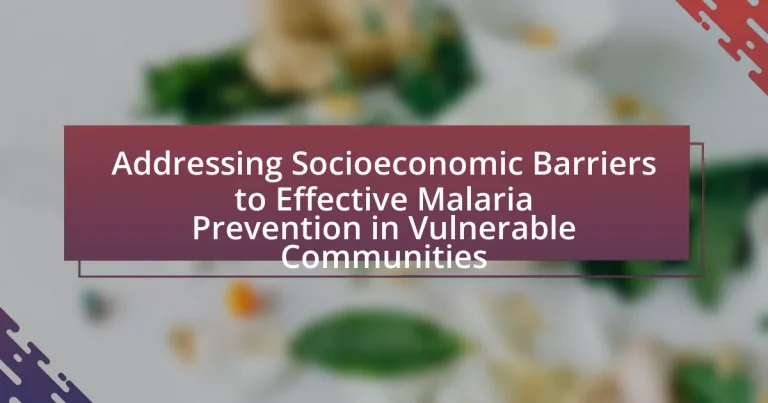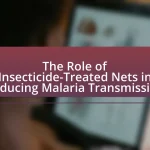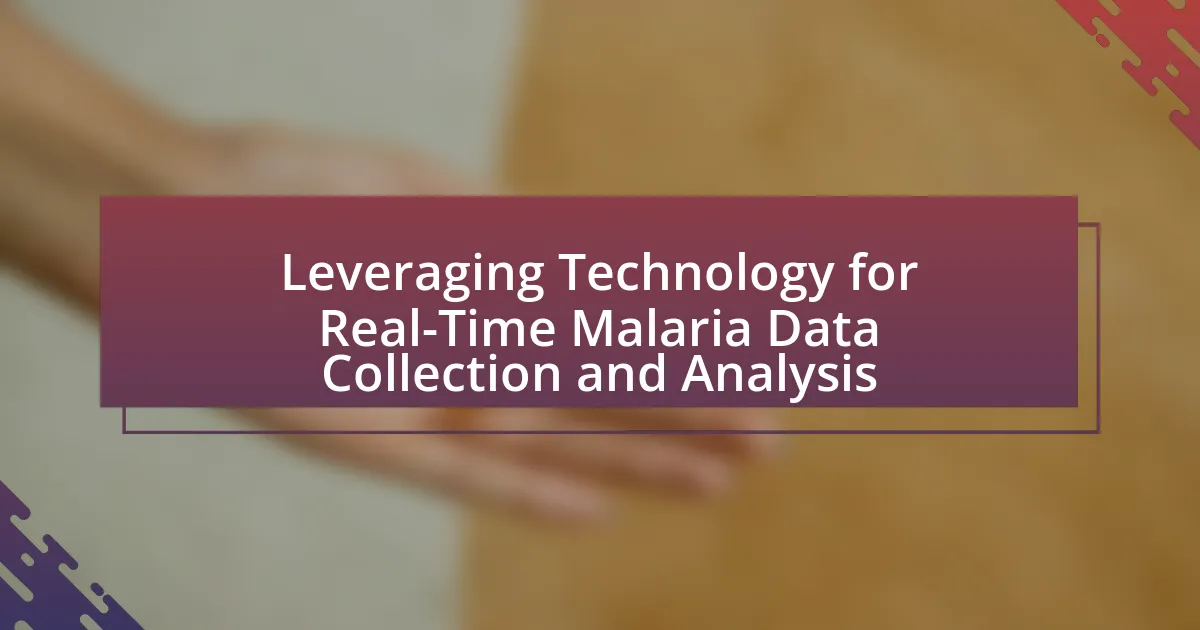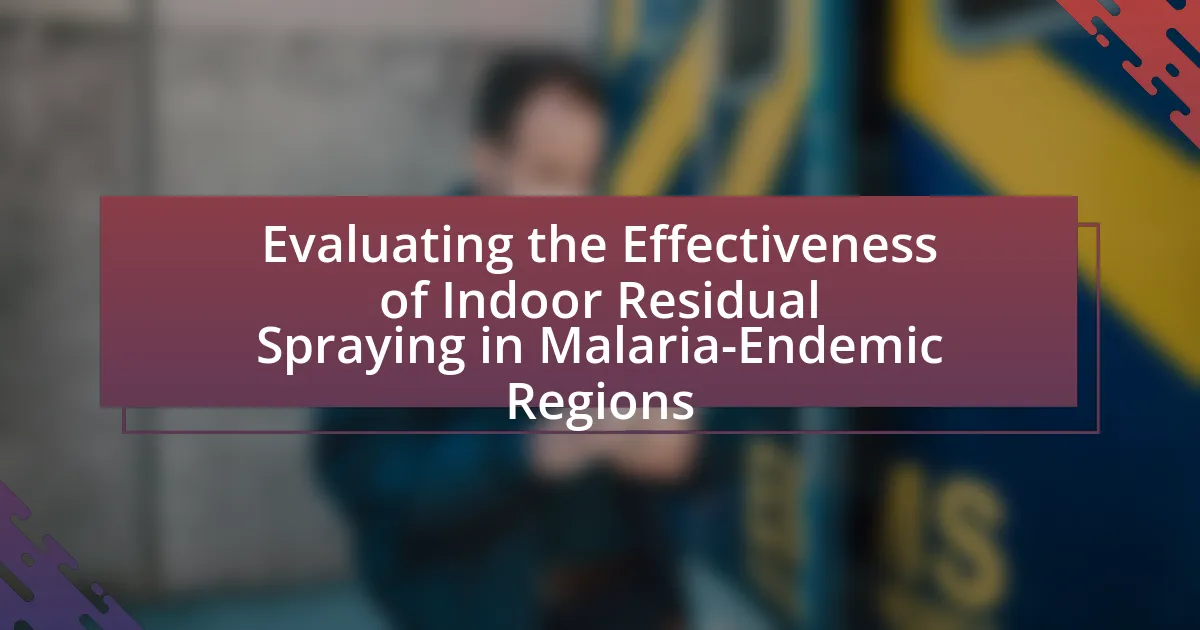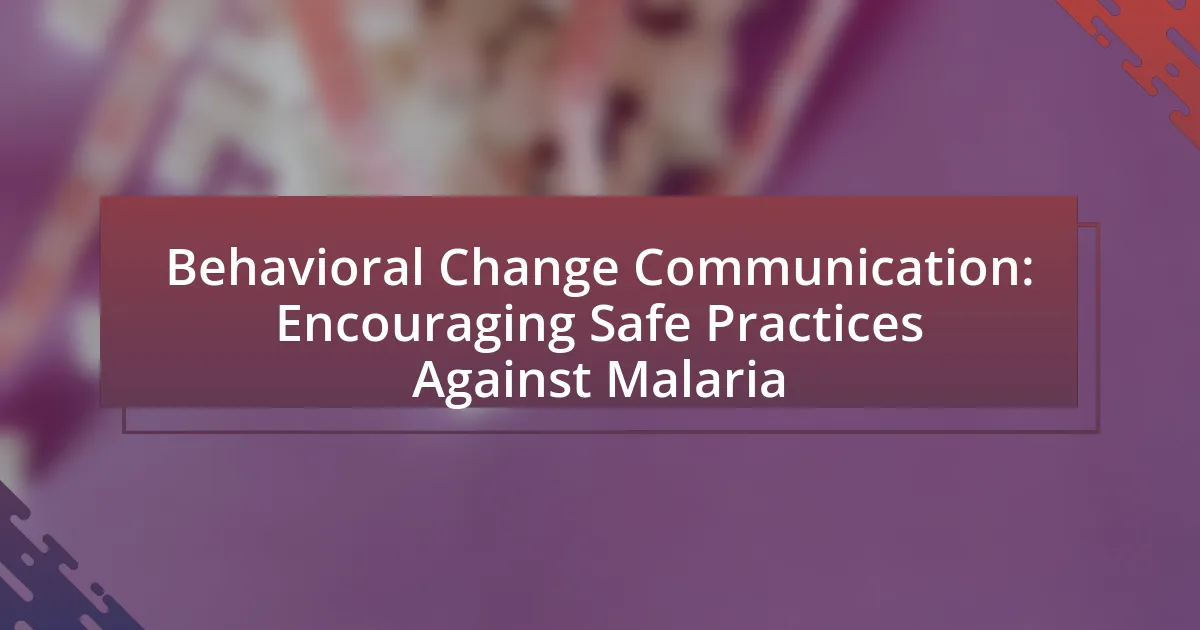The article addresses the socioeconomic barriers to effective malaria prevention in vulnerable communities, highlighting key factors such as poverty, lack of access to healthcare, and inadequate education. It discusses how these barriers limit access to essential resources like insecticide-treated nets and antimalarial medications, exacerbating malaria transmission. The article emphasizes the importance of targeted interventions, community engagement, and culturally sensitive approaches to improve awareness and utilization of malaria prevention strategies. Additionally, it explores the role of government policies, innovative solutions, and continuous education in overcoming these challenges and enhancing health outcomes in high-burden areas.
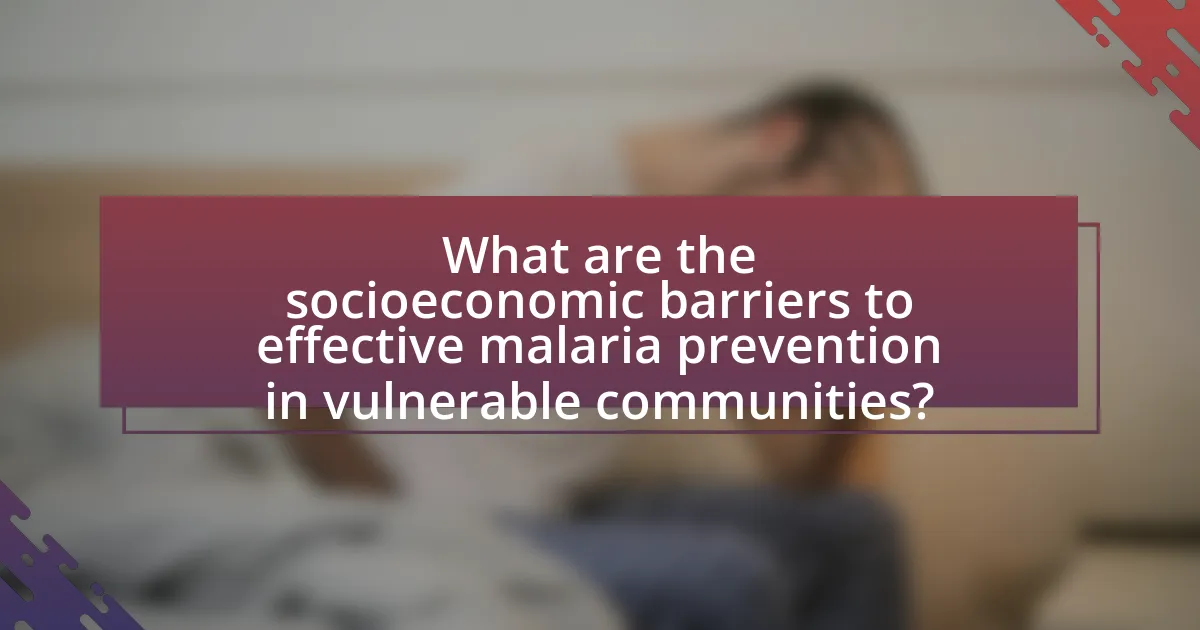
What are the socioeconomic barriers to effective malaria prevention in vulnerable communities?
Socioeconomic barriers to effective malaria prevention in vulnerable communities include poverty, lack of access to healthcare, and inadequate education. Poverty limits financial resources for purchasing preventive measures such as insecticide-treated nets and antimalarial medications. Additionally, communities with limited access to healthcare facilities often face challenges in receiving timely diagnosis and treatment, which exacerbates malaria transmission. Furthermore, inadequate education leads to a lack of awareness about malaria prevention methods, resulting in lower utilization of available resources. According to the World Health Organization, these factors significantly hinder efforts to control malaria in high-burden areas, highlighting the need for targeted interventions that address these socioeconomic challenges.
How do poverty and lack of resources impact malaria prevention efforts?
Poverty and lack of resources significantly hinder malaria prevention efforts by limiting access to essential healthcare services, preventive measures, and education. In impoverished communities, individuals often cannot afford bed nets, insecticides, or antimalarial medications, which are crucial for preventing malaria transmission. For instance, the World Health Organization reports that in low-income regions, the use of insecticide-treated nets is substantially lower, with only 50% of households in these areas having access compared to higher-income regions. Additionally, inadequate healthcare infrastructure in impoverished areas leads to delayed diagnosis and treatment, exacerbating malaria’s impact. Consequently, the cycle of poverty and malaria persists, as affected individuals may miss work or school, further entrenching economic hardship and limiting community resources for effective malaria control.
What specific resources are often lacking in vulnerable communities?
Vulnerable communities often lack access to healthcare services, clean water, and adequate nutrition. These deficiencies hinder effective malaria prevention efforts, as limited healthcare access reduces the ability to diagnose and treat malaria promptly. According to the World Health Organization, approximately 70% of malaria cases occur in areas with inadequate healthcare infrastructure, highlighting the critical need for improved medical resources. Additionally, the lack of clean water contributes to the breeding of malaria-carrying mosquitoes, while poor nutrition weakens immune systems, making individuals more susceptible to infections.
How does poverty influence access to healthcare and prevention methods?
Poverty significantly limits access to healthcare and prevention methods, particularly in vulnerable communities. Individuals living in poverty often face financial barriers that prevent them from seeking medical care, such as high costs of treatment, transportation, and associated expenses. For instance, a study published in the American Journal of Public Health found that low-income populations are less likely to utilize preventive healthcare services, leading to higher rates of disease incidence. Additionally, poverty restricts access to essential resources like clean water, nutritious food, and education about health practices, further exacerbating health disparities. Consequently, these socioeconomic factors create a cycle of poor health outcomes and limited access to effective malaria prevention strategies.
What role does education play in malaria prevention?
Education plays a crucial role in malaria prevention by increasing awareness and understanding of the disease, its transmission, and preventive measures. Educated individuals are more likely to adopt effective practices such as using insecticide-treated bed nets, seeking timely medical treatment, and participating in community health initiatives. Research indicates that communities with higher levels of education report lower malaria incidence rates, as education empowers individuals to make informed health decisions and engage in preventive behaviors. For instance, a study published in the American Journal of Tropical Medicine and Hygiene found that educational interventions significantly improved knowledge about malaria and increased the use of preventive measures among participants.
How does the level of education affect awareness of malaria risks?
The level of education significantly affects awareness of malaria risks, as higher educational attainment correlates with increased knowledge about malaria transmission, prevention, and treatment. Studies indicate that individuals with secondary or higher education levels are more likely to understand the symptoms of malaria and the importance of preventive measures, such as the use of insecticide-treated nets and seeking timely medical care. For instance, research conducted in sub-Saharan Africa shows that educated individuals are 1.5 to 2 times more likely to utilize malaria prevention strategies compared to those with no formal education. This enhanced awareness is crucial for effective malaria prevention in vulnerable communities, as it leads to better health outcomes and reduced transmission rates.
What educational programs can help improve malaria prevention knowledge?
Educational programs that can help improve malaria prevention knowledge include community health education initiatives, school-based health curricula, and training for healthcare workers. Community health education initiatives, such as those implemented by organizations like the World Health Organization, focus on disseminating information about malaria transmission, prevention methods, and the importance of using insecticide-treated nets. School-based health curricula, which have been adopted in various countries, teach children about malaria prevention, thereby fostering awareness from a young age. Additionally, training programs for healthcare workers enhance their ability to educate patients and communities about malaria prevention strategies, leading to improved public health outcomes. These programs have been shown to increase knowledge and reduce malaria incidence in affected regions.
How do cultural beliefs and practices affect malaria prevention?
Cultural beliefs and practices significantly influence malaria prevention by shaping community attitudes towards health interventions. For instance, in some cultures, traditional healing practices may be preferred over modern medical approaches, leading to lower acceptance of preventive measures such as insecticide-treated nets or antimalarial medications. A study published in the American Journal of Tropical Medicine and Hygiene found that communities with strong beliefs in spiritual causes of illness often resist biomedical interventions, which can hinder effective malaria control efforts. Additionally, cultural norms regarding gender roles can affect the distribution and use of preventive resources, as women may have limited decision-making power regarding health practices in certain societies. These cultural dynamics underscore the importance of integrating local beliefs into malaria prevention strategies to enhance community engagement and compliance.
What cultural factors contribute to resistance against malaria prevention measures?
Cultural factors that contribute to resistance against malaria prevention measures include traditional beliefs, social norms, and mistrust of external interventions. Traditional beliefs may prioritize herbal remedies over scientifically proven methods like insecticide-treated nets or antimalarial medications, leading to a preference for local practices. Social norms can discourage the use of preventive measures if they are not widely accepted within the community, resulting in collective non-compliance. Additionally, mistrust of government or foreign health initiatives can stem from historical exploitation or ineffective past interventions, causing communities to reject malaria prevention strategies. These factors collectively hinder the adoption of effective malaria control measures, as evidenced by studies showing that communities with strong adherence to traditional practices often report lower usage rates of modern prevention tools.
How can culturally sensitive approaches enhance malaria prevention efforts?
Culturally sensitive approaches can enhance malaria prevention efforts by ensuring that interventions are tailored to the beliefs, practices, and social structures of the target communities. This alignment increases community engagement and acceptance, leading to higher participation rates in prevention programs. For instance, a study published in the American Journal of Tropical Medicine and Hygiene found that integrating local customs and languages into health messaging significantly improved the understanding and adoption of malaria prevention measures, such as the use of insecticide-treated nets. By respecting cultural norms and involving community leaders in the planning and implementation of malaria control strategies, these approaches foster trust and collaboration, ultimately resulting in more effective and sustainable health outcomes.
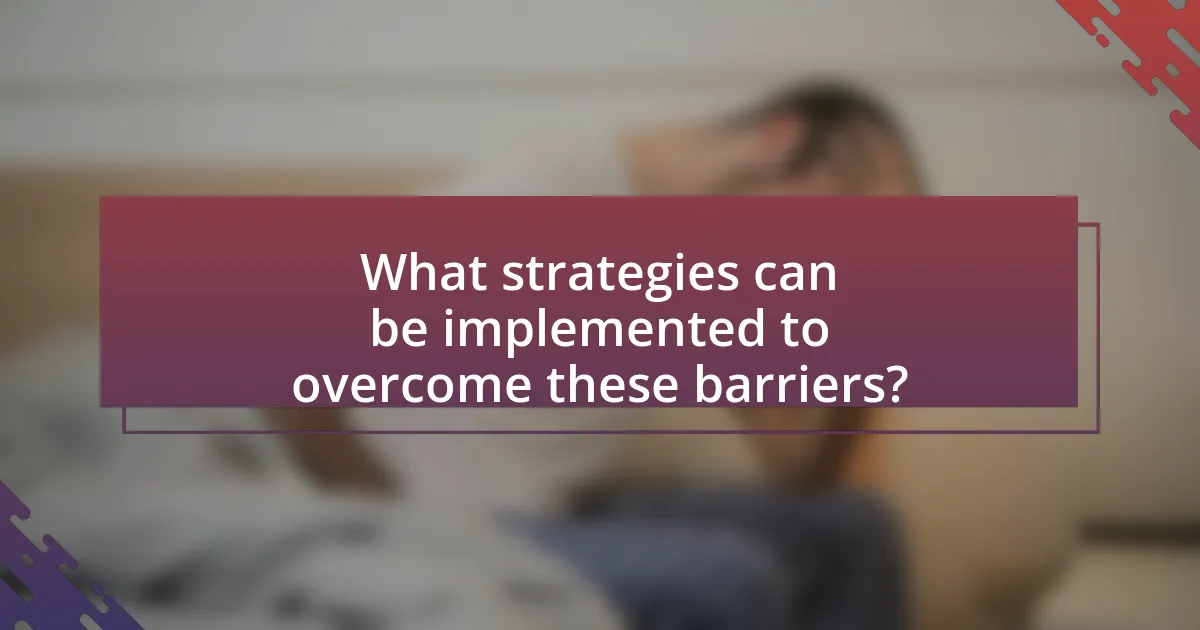
What strategies can be implemented to overcome these barriers?
To overcome socioeconomic barriers to effective malaria prevention in vulnerable communities, targeted interventions such as subsidized healthcare access, community education programs, and distribution of preventive tools like insecticide-treated nets can be implemented. These strategies address financial constraints by reducing costs associated with malaria prevention and treatment, thereby increasing accessibility for low-income populations. For instance, studies have shown that subsidizing the cost of insecticide-treated nets significantly increases their uptake in impoverished areas, leading to a measurable decrease in malaria incidence. Additionally, community education initiatives raise awareness about malaria prevention methods, empowering individuals to take proactive measures against the disease.
How can community engagement improve malaria prevention?
Community engagement can significantly improve malaria prevention by fostering local ownership and participation in health initiatives. When communities are actively involved in malaria prevention efforts, they are more likely to adopt and sustain preventive measures, such as using insecticide-treated bed nets and participating in indoor residual spraying programs. Research indicates that community-led interventions can increase bed net usage by up to 50%, as seen in studies conducted in sub-Saharan Africa. Additionally, engaged communities can facilitate better communication about malaria transmission and symptoms, leading to earlier diagnosis and treatment. This collaborative approach not only enhances awareness but also builds trust in health services, ultimately reducing malaria incidence and improving health outcomes in vulnerable populations.
What are effective methods for involving local leaders in malaria prevention?
Effective methods for involving local leaders in malaria prevention include establishing partnerships, facilitating community engagement, and providing training programs. Local leaders can leverage their influence to mobilize community resources and promote awareness about malaria prevention strategies. For instance, studies have shown that when local leaders participate in health initiatives, such as community health education campaigns, there is a significant increase in community participation and adherence to preventive measures. Additionally, training local leaders on malaria transmission and prevention can empower them to disseminate accurate information and encourage community action, leading to improved health outcomes.
How can community health workers facilitate better access to prevention resources?
Community health workers can facilitate better access to prevention resources by serving as trusted liaisons between healthcare systems and vulnerable populations. They provide education on malaria prevention methods, such as the use of insecticide-treated nets and indoor residual spraying, which are critical in reducing transmission rates. Research indicates that community health workers improve health outcomes by increasing awareness and utilization of preventive measures; for instance, a study published in the American Journal of Tropical Medicine and Hygiene found that communities with active health worker programs saw a 30% increase in the use of malaria prevention resources. By addressing local misconceptions and barriers, community health workers enhance the community’s ability to access and implement effective malaria prevention strategies.
What role do government policies play in addressing socioeconomic barriers?
Government policies play a crucial role in addressing socioeconomic barriers by implementing targeted interventions that promote equity and access to resources. These policies can include financial assistance programs, healthcare access initiatives, and educational reforms aimed at reducing disparities among vulnerable populations. For instance, the World Health Organization emphasizes that effective malaria prevention requires addressing underlying socioeconomic factors, such as poverty and education, which are often exacerbated by inadequate government support. By allocating resources and creating frameworks that empower disadvantaged communities, government policies can significantly enhance the effectiveness of malaria prevention efforts and improve overall health outcomes.
How can policy changes improve resource allocation for malaria prevention?
Policy changes can improve resource allocation for malaria prevention by prioritizing funding and support for targeted interventions in high-burden areas. For instance, reallocating resources to community-based programs that distribute insecticide-treated nets and provide access to rapid diagnostic tests can significantly reduce malaria transmission rates. Evidence from the World Health Organization indicates that countries implementing focused policy reforms, such as increasing budget allocations for malaria control, have seen a 30% reduction in malaria cases over five years. By aligning policies with local needs and ensuring equitable distribution of resources, governments can enhance the effectiveness of malaria prevention strategies in vulnerable communities.
What successful policies have been implemented in other regions?
Successful policies implemented in other regions to address socioeconomic barriers to effective malaria prevention include the distribution of insecticide-treated bed nets (ITNs) in sub-Saharan Africa, which has significantly reduced malaria incidence. For instance, a study published in The Lancet in 2019 indicated that countries like Rwanda and Ethiopia achieved a 50% reduction in malaria cases after widespread ITN distribution combined with community education programs. Additionally, cash transfer programs in Zambia have incentivized families to seek preventive care and treatment, leading to improved health outcomes and increased use of malaria prevention measures. These policies demonstrate the effectiveness of combining direct interventions with socioeconomic support to enhance malaria prevention efforts.
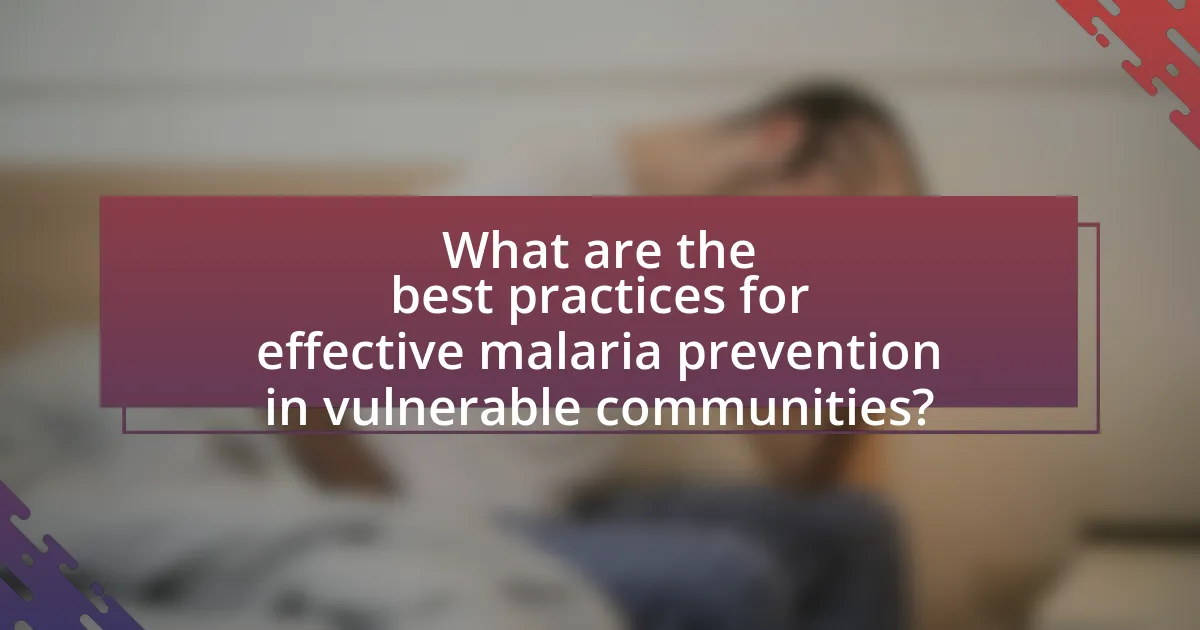
What are the best practices for effective malaria prevention in vulnerable communities?
Effective malaria prevention in vulnerable communities includes the use of insecticide-treated bed nets (ITNs), indoor residual spraying (IRS), and community education on malaria transmission and prevention. ITNs significantly reduce malaria transmission by providing a protective barrier against mosquito bites; studies show that their use can decrease malaria cases by up to 50% in high-risk areas. IRS involves applying insecticides to the interior walls of homes, which can kill mosquitoes that rest indoors, further reducing transmission rates. Community education initiatives raise awareness about malaria symptoms, prevention methods, and the importance of seeking treatment, which can lead to earlier diagnosis and reduced morbidity. These practices are supported by the World Health Organization, which emphasizes their effectiveness in reducing malaria incidence in vulnerable populations.
What innovative solutions have been developed to address socioeconomic barriers?
Innovative solutions developed to address socioeconomic barriers include the implementation of community health worker programs, which enhance access to malaria prevention resources in underserved areas. These programs train local individuals to provide education, distribute insecticide-treated nets, and facilitate access to healthcare services, effectively bridging the gap between vulnerable communities and essential malaria prevention tools. Evidence from the World Health Organization indicates that such community-based interventions can significantly increase net usage and reduce malaria incidence, demonstrating their effectiveness in overcoming socioeconomic obstacles.
How can technology be leveraged to improve malaria prevention efforts?
Technology can be leveraged to improve malaria prevention efforts through the use of mobile health applications, remote sensing, and data analytics. Mobile health applications facilitate real-time communication and education about malaria prevention methods, enabling communities to receive timely information on prevention strategies and treatment options. Remote sensing technology allows for the mapping of mosquito breeding sites, which helps in targeted interventions, while data analytics can identify high-risk areas and optimize resource allocation for prevention efforts. For instance, the World Health Organization reported that mobile health initiatives have increased awareness and access to preventive measures in regions with high malaria prevalence, demonstrating the effectiveness of technology in enhancing malaria prevention.
What partnerships can enhance resource distribution for malaria prevention?
Public-private partnerships can enhance resource distribution for malaria prevention by leveraging the strengths of both sectors. For instance, collaboration between governments and pharmaceutical companies can facilitate the development and distribution of antimalarial drugs and vaccines, ensuring they reach vulnerable populations. Additionally, partnerships with non-governmental organizations (NGOs) can improve community outreach and education, increasing awareness and access to preventive measures such as insecticide-treated bed nets. Evidence from the World Health Organization indicates that integrated efforts involving multiple stakeholders lead to more effective malaria control strategies, ultimately reducing transmission rates in high-risk areas.
What practical steps can communities take to improve malaria prevention?
Communities can improve malaria prevention by implementing targeted vector control measures, such as distributing insecticide-treated bed nets and conducting indoor residual spraying. These methods have been shown to significantly reduce malaria transmission; for instance, the World Health Organization reports that the use of bed nets can decrease malaria cases by up to 50% in high-risk areas. Additionally, communities should engage in regular health education campaigns to raise awareness about malaria symptoms, prevention strategies, and the importance of seeking timely medical care. Evidence from various studies indicates that informed communities are more likely to adopt preventive measures, leading to lower infection rates. Furthermore, establishing local partnerships with health organizations can enhance resource mobilization and ensure sustainable malaria control efforts.
How can local organizations mobilize resources for effective malaria prevention?
Local organizations can mobilize resources for effective malaria prevention by forming partnerships with government agencies, NGOs, and community stakeholders to pool financial and logistical support. These collaborations can enhance access to funding opportunities, such as grants from international health organizations, which have been shown to significantly increase resource availability for malaria initiatives. For instance, the Global Fund to Fight AIDS, Tuberculosis and Malaria has provided substantial financial assistance to local programs, enabling them to implement preventive measures like insecticide-treated nets and community health education. Additionally, local organizations can leverage community engagement to raise awareness and encourage volunteerism, which can further amplify resource mobilization efforts.
What role does continuous education play in sustaining malaria prevention efforts?
Continuous education is crucial for sustaining malaria prevention efforts as it empowers communities with knowledge about transmission, prevention methods, and treatment options. By providing ongoing training and information, individuals are more likely to adopt preventive measures such as using insecticide-treated nets and seeking timely medical care. Studies have shown that communities engaged in continuous education programs experience a significant reduction in malaria incidence, as informed individuals are better equipped to recognize symptoms and understand the importance of preventive practices. For instance, a study published in the American Journal of Tropical Medicine and Hygiene found that educational interventions led to a 30% increase in the use of preventive measures in high-risk areas. This demonstrates that continuous education not only enhances awareness but also directly contributes to the effectiveness of malaria prevention strategies.
